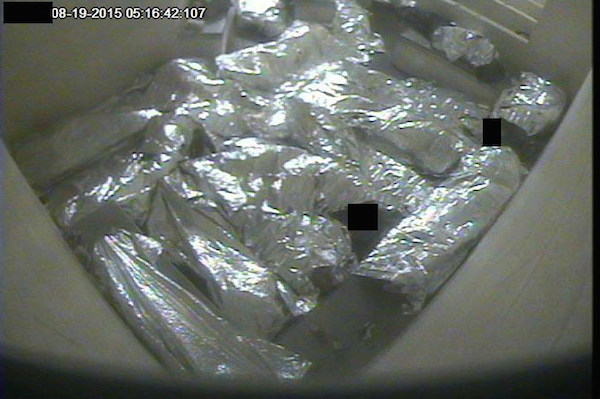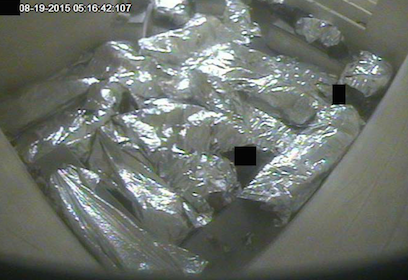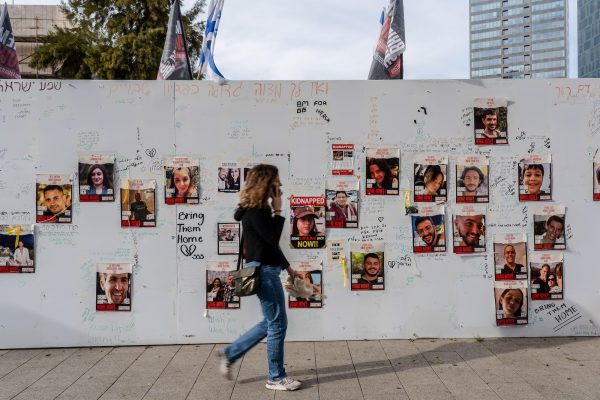
A still from video surveillance at a U.S. Customs and Border Protection facility in Tuscon. Image: National Immigration Law Center
On August 19 the New York Times released stills of video surveillance of cement cells and hold rooms at Tuscon’s Customs and Border Protection (CBP) detention facilities. The eerie pictures show strange figures—it takes a moment to realize they must be human bodies—crammed together, huddled on the floor, alongside each other, against benches. Indistinguishable, long irregular lines of figures give off a metallic sheen. They are wrapped in Mylar. Some photos show a single water jug. In another there is a lone toilet with no privacy. Another depicts an infant and a toddler in a garbage-strewn cell. The scenes defy decency, and according to a lawsuit—Jane Doe #1, et al. v. Jeh Johnson, et al.—the conditions reflect a deliberate indifference to harm that violates the due process clause of the Fifth Amendment. The groups arguing for the plaintiffs include the ACLU of Arizona, the National Immigration Law Center, the American Immigration Council, the Lawyers’ Committee for Civil Rights of the San Francisco Bay area, and the California and Tokyo offices of the international law firm Morrison & Foerster.
In the discriminatory profiling and preventive detentions that have come to characterize what we call “homeland security,” nothing seems as crucial or contentious as the patrolling of the Mexico/Arizona Border. The CBP, tasked with that work, is the largest law enforcement agency in the United States. It is also the least accountable. CBP monitors eight Southwest border sectors; the Tucson Sector is one of the busiest, covering 262 miles from the Yuma County line to the Arizona/New Mexico state line. Agents have seized and detained more than 200,000 individuals in the past two years alone.
Detainees are held not just in overcrowded cells but in a kind of legal limbo.
Though nominally focused on terrorists and drug smugglers, CBP agents stop anyone desperate enough to make the journey through the Sonoran Desert. Those taken into custody are held for one to five days in processing facilities designed to hold detainees only for hours. Most are then released to long-term immigration detention facilities, processed for deportation, or await hearings before an immigration court judge. CBP detainees are held not just in overcrowded cells but in a kind of legal limbo.
The photos published in the New York Times exposed conditions where the law’s reach is tenuous and a culture of impunity prevails. As civil detainees are not convicted of any crime, the Eighth Amendment prohibition against cruel and unusual punishment does not apply, and even though detainees face harsher conditions than many in local jails or state prisons, it is much harder to raise a legal challenge because of the relatively short period of detention.
Most unsettling about the photos published last month is the protracted story of their release. Advocates fighting to bring them to light were met with the powerful obstructionism of the federal government: defensive maneuvers, vigorous disavowals of harm, and sanctimonious attempts to rationalize the welter of crimes committed in the name of security.
• • •
The initial complaint, filed on June 8, 2015, was brought on behalf of civil detainees in CBP facilities in the Tucson Sector of the U.S. Border Patrol and against CBP officials allegedly acting in violation of the due process clause of the Fifth Amendment, which prohibits the government from depriving anyone—regardless of immigration status—of “life, liberty, or property, without due process of law.” No concept has been more central to constitutional law.
According to Daniel Pochoda, senior counsel of Arizona’s ACLU, the CBP facility’s abysmal conditions had been known to the public for years, following many reports and complaints. But legal advocacy was slow moving, given the short-term duration of CBP detention. To file suit, lawyers need to identify a plaintiff detained at the time of filing, but access to detainees is extremely limited. “There are no ways to even know who is detained while there, no phones for detainees to reach—or be contacted by—attorneys, nor family or friends,” Pochoda explains. “And any viable lawsuit seeking injunctive relief must be brought by individually named plaintiffs while suffering or threatened with the harms.” It is easier to file suit alleging the improper treatment of inmates in Immigration and Customs Enforcement facilities or in jails and prisons housing domestic populations, and indeed many such cases have been successful.
Eventually the legal team did succeed in naming three individuals as plaintiffs, which in turn allowed the lawyers to pursue a class action suit, the kind typically filed in federal courts to challenge confinement conditions on constitutional and other grounds. Their Motion for Class Certification, filed in U.S. District Court in Tucson, defined the plaintiffs as all those who are now or will be detained overnight in a Tucson Sector facility. This class likely includes tens of thousands of people each year.
The fifty-six pages of the complaint set out the conditions in the Tucson Sector hold cells, asking for injunctive relief. It describes the harm and risk of harm the detainees face, from the withholding of medicine and medical care to forced removal of clothes and the lack of beds, drinking water, and even diapers for infants. Detailing scenes of malicious treatment, it charges that the defendants are “intentionally indifferent” to “harsh, excessive, and punitive conditions.”
The declarations of fifty recently detained immigrants, used as exhibits in the complaint, testify to their suffering. The plaintiffs range in age from nineteen to fifty-one-years-old. Their depositions are repetitive and flat. Buried in the bare recitations are litanies of abuse and mistreatment.
Prisoners routinely describe their treatment as “humiliating,” “a form of torture.” Children are treated as badly as everyone else, they say. One child arriving at a CBP detention facility reports being told by officials, “Welcome to Hell.” A twenty-three-year-old woman, fleeing from Guatemala, told the lawyers, “I am currently five months pregnant. When I arrived at the Border Patrol Station, I told the agents I was pregnant, but the agents were very hostile and did not believe me. They insulted me and poked my stomach and said there wasn’t anything there.”
For days at a time, detainees, including children, are forced to sleep on concrete floors in cold rooms referred to as hieleras, Spanish for “freezers” or “iceboxes.”
The most frequent reports of abuse describe forced, lengthy stays in freezing cold temperatures. Detainees recount how agents take away their sweaters, jackets, pants, “extra layers,” and blankets before locking them up. When they complained about cold, they were mocked and threatened. “When people asked the guards to make it warmer, they made it colder,” a detainee said. “Sometimes they laughed at us when we complained about the temperature.”
The plaintiffs also describe how they slept on floors and benches in overcrowded hold rooms and cells; no beds were provided. The spaces are usually too packed with bodies to allow everyone to lie down. Floors are strewn with trash, soiled diapers, and uneaten food. Lights are left on through the night. There are no showers or soap, and no hot water. Nor are there kitchens to prepare meals for the detained; inmates are given juice, a cold or rotten burrito, and crackers. Water is delivered in one dirty container to be passed around and shared.
A young man with heart problems could not get pills for his ailment, and agents confiscated the medication a woman from Mexico had been prescribed for an ovarian cyst. Migrants were not allowed to contact their consulates or to use a phone to contact family members, whether at home or in the United States.
Detainees were taunted, and in some cases even terrorized. “If we stood up and looked out the window,” a young Mexican woman said, “they would make fun of us and tell us that they would punish us if we stood there.” Dogs are used to humiliate and scare. Just over a year ago, one plaintiff was caught with her sister and ten others in southern Arizona. They were handcuffed and left in the sun for two hours without food or water; then a border agent’s dog was let loose. “Agents took pictures with their cell phones, laughed, and joked that the photographs were ‘for the dog’s Facebook account.’”
The harms are exacerbated by the cold; detainees recount shivering in pain. In one detainee’s words, sleeping on the concrete floor “was like trying to sleep on ice.” “The thin aluminum blanket did not keep me warm,” another explains. “I had to curl up to stay as warm as possible but I was still cold. I could not sleep at all because of the cold and because the blankets made so much noise.” A sixth-month-old baby cried constantly. Her mother recalled how she “was shivering from the cold as she slept” on the concrete floor.
According to Pochoda, the case is “exceptional,” even within the universe of suits challenging conditions of prisons and jails. The CBP conditions suggest the malicious indifference of federal officials. In a report filed this summer in support of the case, Eldon Vail, former deputy secretary for the Washington State Department of Corrections, agrees:
I have worked in correctional organizations for thirty-five years. During my career . . . I have been in countless prisons and jails. Those facilities house individuals who have been charged with or convicted of felonies and misdemeanors. I have never been in one that treats those confined in a manner that the CBP treats detainees. The absence of medical screening upon arrival is unthinkable. Sufficient food, water and clothing are fundamental to safe, secure and humane operation but I have never seen the challenges the CBP creates for detainees for access to these basic necessities. I have seen and experienced the effects of overcrowding but no jurisdiction would cram so many people into so little space, without beds and bedding, that routinely occurs in CBP facilities. The conditions of confinement I witnessed through my inspections and through studying the records in this case are unthinkable in any other jurisdiction that I have seen or heard about. These conditions seem to me to be designed to punish and that is not the role of the Border Patrol.
• • •
On January 11 this year, the court granted the plaintiff’s motion for class certification. The decision enables greater access to detainees and will increase the impact of all court-ordered changes. Pochoda believes the case could be “the critical step in accomplishing much needed structural change” because it could affect the conditions of immigration detention all along the border.
Yet in the months following the class certification, the federal government fought hard to delay, suspend, or dismiss the suit and conceal conditions inside these facilities. The defendants named are Jeh Johnson, Secretary of the U.S. Department of Homeland Security; R. Gil Kerlikowske, Commissioner and head of CBP; Michael J. Fisher, the Border Patrol Chief; Jeffrey Self, the Commander of the Arizona Joint Field Command of CBP; and Manuel Padilla, Jr., the Chief Patrol Agent for the U.S. Border Patrol’s Tucson Sector. Not only did the defense object to and oppose the plaintiffs’ motions from October 2015 until as late as February 2016, but it consistently argued that no harm was done. In Defendants’ Reply in Support of Their Motion to Dismiss, filed on October 5, defendants baldly denied holding detainees “in unsanitary and hazardous hold cells” and claimed that plaintiffs “glossed over the critical legal distinction between short- and long-term detention.” Defendants also stated that “no plaintiff alleges any injury that could have necessitated medical attention.” Each of these arguments for dismissal flies in the face of plaintiffs’ depositions, filed four months earlier. As late as February 25, the defendants argued that medical care is “constitutionally sufficient.” “Plaintiffs do not provide a single example of a serious medical condition for which any delay in or denial of care resulted in any serious harm,” the document claims.
‘The conditions . . . are unthinkable,’ says the former deputy secretary of the Washington State Department of Corrections.
In his ruling on January 11, Tuscon Senior U.S. District Judge David Bury took the defendants to task:
It is also not the case, as defendants argue, that the named plaintiffs have failed to allege some form of harm. Plaintiffs assert in the complaint that ‘[t]he inhumane and dangerous conditions in the Tucson Sector facilities result in irreparable, ongoing physical and psychological harm to plaintiffs and putative class members and serious risk of future harm.’
In response to the government’s argument that the plaintiffs did not allege specific harm, Bury enumerates the many asserted “injuries.” “A partial sampling of allegations shows . . . that each of named plaintiffs allegedly endured cold temperatures with minimal clothing, lack of beds or bedding, loss of sleep, lack of proper hygienic supplies, lack of medical screening, constant illumination, and little food or water while in CBP custody.”
Ongoing motions by the defendants also attempted to “partially seal” documents not yet released. According to the Arizona Republic, the defendants argued that images be concealed because releasing them would “violate privacy rights of immigrants and jeopardize security.”
Defendants also destroyed surveillance recordings, evidence the court ruled must be preserved. Between July 8 and August 14 last year, defendants deleted video footage or recorded over it. Judge Bury refused the government’s motion to exclude the surveillance video of immigrants in CBP custody and related expert testimony. This year, just over a year after the case began, Bury, exasperated by the defendants’ deliberate obstruction, ordered the release of all existing surveillance video footage. Only then could the public witness what the government officials fought so hard to keep from being exposed.
• • •
American punishment and abuse has a long memory. The styles, forms, and practices of legalized injury at work in incarceration today are recognizable in that oldest and most peculiar of U.S. institutions, slavery. What unites them is the obliteration of the distinction between person and thing.
Take solitary confinement, the modern tactic of dehumanization par excellence, which transforms living bodies not exactly into corpses, but into some liminal state between life and death. Deprived of windows, natural light, and contact with other human beings, warehoused indefinitely in what Human Rights Watch once called “cold storage,” inmates fight against the numbing of mind and thought. They describe life in supermax confinement as “being freeze dried.” This is a reality in CBP detention centers, too. For days at a time, detainees, including children, are forced to sleep on concrete floors in cold rooms referred to as hieleras, Spanish for “freezers” or “iceboxes.”
Yet the law has little power to fight such barbarities. The primary focus of the CBP case is the absence of beds in cells and hold rooms, not the guards’ sadistic manipulation of temperature. Defendants can and will quibble about whether it is cold; it is their word against that of plaintiffs. More robust pieces of legal evidence are the photos showing a pile of mattresses in an empty room, while inmates lie on the floors of overcrowded cells.
The decision on a preliminary injunction is still pending, but lawyers for the detainees have begun the process of discovery. If the injunction is granted, defendants will be required to make improvements, even though a trial and final decision could be some two years ahead, Pochoda says. He hopes that there is incentive for defendants to settle before then. The twists and turns in Jane Doe #1, et al. v. Jeh Johnson, et al. demonstrate how hard it is to bring justice to individuals outside the pale of human empathy, lost in what Hannah Arendt called “holes of oblivion.” For them, the wheels of justice turn all too slowly.






